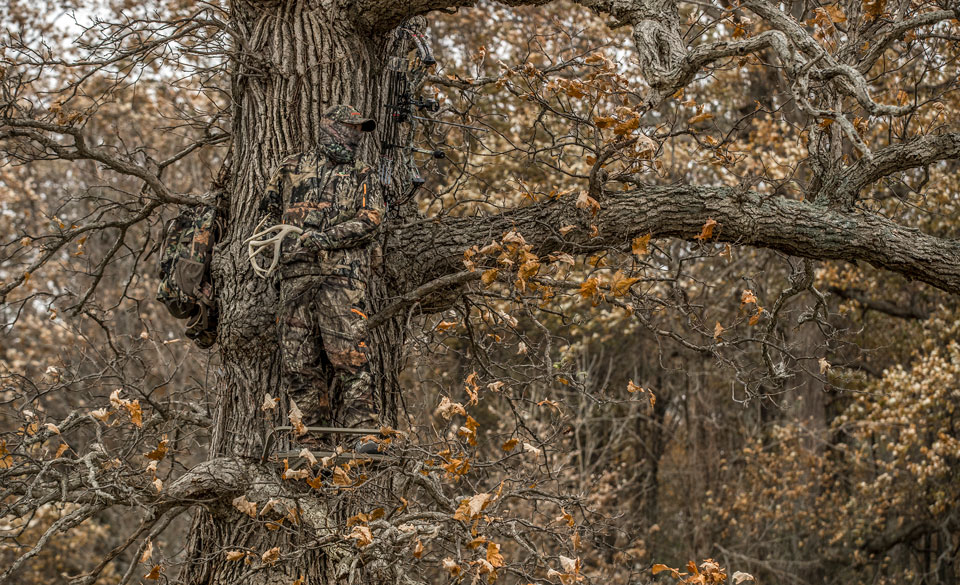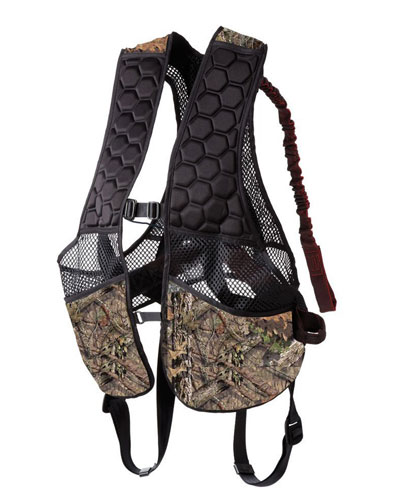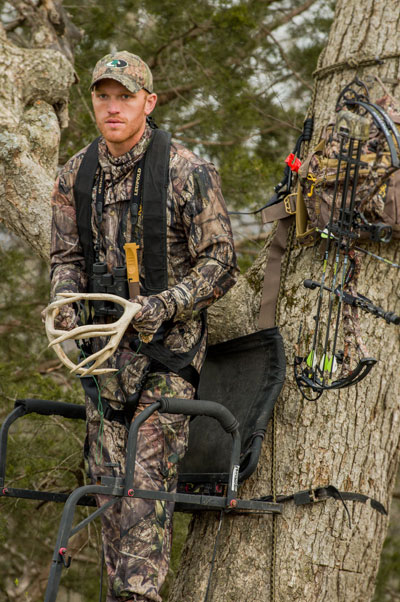Bob Humphrey | Originally published in GameKeepers: Farming for Wildlife Magazine

I reached the big fir tree and started climbing to my hang-on stand just as I’d done a dozen times before, albeit a bit more tentatively. This was my first attempt at climbing after recovering from a dislocated shoulder and I was unsure how it would hold up. It turned out to be more of a test than I ever could have anticipated.
The lower limbs were sufficiently spaced to provide an adequate means of ascent, or so I thought. I was about halfway up, reaching with my good arm when one of my “steps,” a dead branch, snapped. There was a split-second of panic as I felt the full weight of my body suddenly exerted on my newly repaired shoulder.
Fortunately it held, and I was able to regain my footing. Things could have gone far worse, and I would have had no-one but myself to blame. I’ve since become a lot less cavalier about how I ascend to my elevated shooting platforms.
The Importance of Tree Stand Safety

their full-body harnesses lighter, more comfortable, easier
to use and more importantly, safer than ever before.
Someone once told me, “If you bowhunt long enough, three things will happen to you. You will shoot a deer and not recover it. You’ll cut yourself on a broadhead and you’ll experience a fall.” Of the three, the latter is likely to be the most serious.
Statistics show that treestand accidents are the leading cause of injury among hunters. The Minnesota Department of Natural Resources reports that one in three people who hunt from an elevated stand will have a fall resulting in serious injury. The most common types are fractures of the spine and extremities, followed by head and lung injuries. Another study estimated 82 percent of those injured were not using a fall arrest system (FAS). The rest were probably not using it correctly.
Tree Stand Safety and Prevention
“An ounce of prevention is worth a pound of cure” and the obvious solution to preventing a fall is wearing a harness. With the odds firmly stacked against you, you’re flirting with disaster if you don’t.
Furthermore, you need to think not only of yourself, but of all those who might be affected by an accident. In the best case, your injuries could result in lost time at work and lost income. In the worst, it could result in a debilitating injury like paralysis or even death, all of which will have a profound effect on those who care about you.
"If you hunt from a treestand and you have somebody that loves you and needs you to come home, you are outright stupid if you don't wear a harness." – Jim Barta, Hunter Safety Systems
There’s no good reason not to wear an FAS, but there are several poor ones that, unfortunately persist. Cost is no excuse. The Treestand Manufacturers Association (TMA) requires all of its members to include an FAS harness and instructions on how to use it with every stand sold - free of charge.
What about comfort? Admittedly, the basic harnesses included with stands may not be the most comfortable. And they can give some hunters fits trying to put them on. If you feel that way, there are plenty of after-market FASs available, and the manufacturers have gone to great lengths to make them comfortable, easy to don and most importantly, safe. Even top-end harnesses with all the bells and whistles are available for under $100.
When you consider how much you spend on other hunting equipment, and the importance of an FAS, that’s a pretty good investment.

an elevated stand.
Now that you’ve purchased a good FAS and promised to use it, there are a few general tree stand safety guidelines to follow, some of which I’ve borrowed from the TMA.
First, make sure your FAS full body harness meets TMA standards. Anything else puts you at risk. And be aware that single strap belts and chest harnesses no longer meet TMA standards.
Next, wear it even (especially) during ascent and descent. Statistics show most falls occur while climbing into or out of stands. Learn how to use your FAS. I know it goes against most guys’ nature, but read and understand the manufacturer’s warnings and instructions before using your FAS.
Practice donning and attaching it at ground level before you head afield. You don’t want to be fumbling around in the dark at the base of your tree on opening day. It could lead to frustration and possibly injury if you put it on hastily.
When you’re practicing with it and between uses, inspect the FAS for signs of wear or damage. Things sometimes go wrong, even with the best products. If you discover a problem, replace rather than repair.
Tree Stand Fall Recovery
Even when properly wearing the best FAS available you still may fall - that’s why you wear it. As its name implies, the FAS will arrest your fall, reducing the chances of serious injury or death, temporarily. But now you’re faced with a new problem.
Properly harnessed and tethered hunters who survive the initial force of a fall are still at risk from something called suspension trauma. It can result in blood pooling in the legs and lack of blood flow to the heart and brain. This is where the added expense of an after-market FAS really pays off. Most now also come with a suspension relief system designed to relieve pressure and help avoid suspension trauma. It may also allow you an opportunity to get back into a safe position.
Just in case you can’t, you should have a rescue plan. Always carry some type of emergency signal device like as a cell phone, radio, whistle, signal flare, personal locator device and flashlight on your person at all times. And make sure it’s somewhere within reach, even while suspended.
Even if you follow all the tree stand safety guidelines to a tee, and are able to contact and notify help, you may have to hang for a while before help arrives. Try to keep your body, especially arms and legs moving. If you can reach a limb and put some weight on it, shift your weight periodically. And above all, try to remain calm.
The take-home message is fairly simple. If you're going to safely and successfully hunt from an elevated stand, ALWAYS wear an FAS. If you don’t or can’t you really only have two options: stay home or hunt from the ground. It might take a few extra minutes, or seconds, but as an educator acquaintance of mine once noted, "I'd rather be tardy than absent, and gravity never takes a vacation."



























